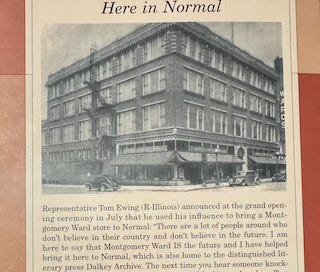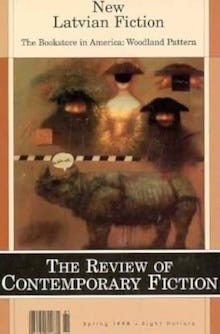As most of you know, in addition to serving as the editor-in-chief for Dalkey Archive Press, I also run Open Letter Books—the press that I co-founded at the University of Rochester after leaving Dalkey Archive in 2006. Right now, Open Letter is celebrating the release of its Latvian Translator Triptych—a collection of three books translated from Latvian, all selected by Kaija Straumanis (who also translated one of the three). You can read all about it here. (And, shameless plug: buy the books! They’re all great!)
But my first exposure to Latvian literature wasn’t via Kaija Straumanis’s triptych, nor her translation of High Tide by Inga Ābele. It was via an issue of the Review of Contemporary Literature from 1998. I was a subscriber back then, and read every issue cover to cover, including the “New Latvian Fiction” issue, one of a handful of issues dedicated to publishing excerpts from a particular country. (The “New Flemish Fiction” issue is another favorite.) In our times, now that Words Without Borders exists, this may seem sort of quaint, but back then? Outside of French, German, and Spanish, translations truly flew under the radar and the idea of sampling a bunch of writers from Latvia of all places was quite rare.
This issue included an overview piece by Nora Ikstena, who is the author of more than twenty works, including Soviet Milk, which is available in the UK from Peirene Press. She’s one of Latvia’s greatest contemporary authors. In fact, in 2018, she was awarded an “Excellence in Culture Award” for being the internationally best-selling Latvian author of this century.
To build on the success of the Latvian Triptych and draw more attention to Ikstena’s work and Latvian literature as a whole, she was kind enough to allow me to rerun her essay from this issue. (Note: If you have access, this issue is available in full via ProQuest, EBSCO, and elsewhere.)
But first, a couple fun notes about this particular issue of RCF . . .
Related to the ongoing season of the Two Month Review podcast, this issue was dedicated to James Laughlin & Kathy Acker, who had both recently passed away. (We’re reading Acker’s Empire of the Senseless next.)
This issue also contained the second (final?) entry in the “Bookstore in America” series, focusing on Woodland Pattern in Milwaukee, Wisconsin. In some other post, I’ll write more about the interview in here with Karl Gartung and Anne Kingsbury (and the intro essay by John O’Brien), along with the earlier feature on Borders and John Evans of Diesel: A Bookstore’s response to the Borders piece. But I want to keep the focus on Latvia . . . except, well, the back cover of this issue is a bit of John O’Brien fun and games:
Here in Normal1
Representative Tom Ewing (R-Illinois) announced at the grand opening ceremony in July that he used his influence to bring a Montgomery Ward store to Normal: “There are a lot of people around who don’t believe in their country and don’t believe in the future. I am here to say that Montgomery Ward IS the future and I have helped bring it here to Normal, which is also home to the distinguished literary press Dalkey Archive. The next time you hear someone knocking Republicans because they are backward-looking or knocking Tom Ewing because he doesn’t care about his district, just remind them of Montgomery Ward. We here in Normal, Illinois, are proud as punch, whatever the hell that expression is supposed to mean, that we have Republicans, and stores, and things like that. And, of course, Dalkey Archive Press.”
On to Nora’s piece!
When will Latvians witness those times, Which other nations are seeing now . . .
These wistful lines, written in 1841 by Latvian writer Jānis Ruğēns, are often quoted when speaking of Latvian self-esteem. Even now, as the twenty-first century draws near, this question remains valid. The twentieth century was not favorable to Latvia and its neighbors Lithuania and Estonia. Only now American readers can acquaint themselves with a selection of stories written by contemporary Latvian writers whose collective memory emerges from the history of hard life, wars, occupations, exiles, and deportations. These experiences, although not firsthand for these young authors, comprise the common experience of the Baltic peoples. These writers’ visions are rooted in a rich culture which has miraculously withstood the tests of time and a mostly ruthless history. And now, they are attempting to tame the new era, writing in a language spoken by fewer than 1.5 million people but which is alive and has something to say about the persona of its people.
Surviving seven hundred years of slavery under the German landed gentry, who called the Latvians die Bauer, "the nation of peasants" created over two million dainas—four-line stanzas which expressed poetic and often philosophical reflections on the phenomena of life—man’s relation to the natural and spiritual worlds, human relations, and the cycle of life from birth to adulthood to death. The dainas were rescued from obscurity for posterity by Krišjānis Barons, active during the time of national awakening of Latvians in the late 1800s, who took it upon himself to immortalize these unique examples of oral tradition in six massive volumes—almost 1.5 million dainas, or one daina per Latvian. These are now popularly regarded by many Latvians as something comparable to the Bible.
Up until their declaration of independence in 1918, Latvians had put up with the dictates of not only the German "lords": the Poles, Swedes, and czarist Russia had also planted their flags on Latvian soil. The twentieth century brought enormous changes to this part of Europe which affected millions of people for many years to come. As the last Russian czar Nicholas II was toppled and Russia was swept away by the chaos of its revolution, and with the German army defeated and driven out of Latvia, Latvians struggled to build up their fledgling state.
Latvia recovered rapidly from the effects of World War I. In the scant twenty years of its sovereignty, Latvian culture flourished and its European context was easily recognizable. Latvia's capital, Riga, with its gems of turn-of-the-century art nouveau buildings, was fondly deemed the Paris of the North. Riga was considered an international city where many ethnic minorities coexisted peacefully.
Visions of pre-World War II were immortalized in the poetry of Aleksandrs Čaks (1901–1950), a romantic modernist, whose oeuvre still lingers in the minds of Latvian readers and continues to be a source of inspiration for contemporary Latvian poetry.
The secret Molotov-Ribbentrop Pact of 1939 signaled for Latvia the end of its brief but vivacious era of rebirth. In 1940 Latvia was annexed by the Soviet Union. Tanks rolled in and arrests began. The majority of Latvians were tragically affected—losing family, friend, and neighbor to the Siberian wastelands. The Soviet wave of terror was followed by the Nazi German occupation which annihilated Latvia's Jewish population. The final wave—the return of the Soviet army following the fall of the Third Reich—left Latvia behind the Iron Curtain for half a century in the postwar division of Europe.
What, then, comprises the collective unconscious of the Latvian nation? Latvia’s newly independent state lies over the layers of history: a former freedom short-lived, a hard agrarian way of life, the eternal struggle to survive in a master-serf relationship-one can tread deeper and deeper into ages tarnished by Time, receding into pre-Christian pantheistic times.
The Latvian language embodies the Latvian soul or consciousness. Oral traditions carried the Latvian language into the nineteenth century when it sprang to life in the written word. Stirred up by the winds of the Russian revolution, Latvian journals, books, and newspapers increasingly disseminated the notion of freedom. Once independent Latvia came to life in 1918, words invoked the common experience.
Latvian literature came under fire as history changed its course under Adolf Hitler and Josef Stalin. Under the long Soviet occupation, words were twisted or destroyed, misconstrued and made malleable by “the authorities,” and poets learned to write between the lines.
The dual proximity of lies and truth, which permeated both art and life in the Soviet era, eventually led to a golden age in Latvian poetry—beginning with Ojārs Vācietis (1933–1983), Vizma Belševica (1931), and Imants Ziedonis (1933—see Flowers of Ice, trans. Barry Callaghan [Toronto, 1987]), and later enriched by the social irony of Uldis Bērzinš (1944), the intellectual poetry of Jānis Rokpelnis (1945), and the popular works of Māra Zālīte (1952), rich in references to folklore and infused with national sentiment. On this side of the Iron Curtain, the consumers of works by Latvian poets and writers were, although bent under the hardships of Soviet rule, wise and avid readers who knew how to read between the lines.
On the other side of the Iron Curtain, emigres in exile sought to preserve their language while integrating into new cultures in the United States, Canada, Germany, Sweden, Australia, England, Venezuela, and other host countries. During the 1960s, New York's “Hell’s Kitchen” group of Latvian writers (Linards Tauns, Gunars Saliņš, and others) soaked up the spirit of American modernism. They sought to maintain their national identity while living as strangers in a strange but comfortable land.
American-Latvian writer Agate Nesaule's autobiographical work A Woman in Amber, published in the United States in 1996, received excellent reviews and for the first time brought to the American public what could be called the Latvian experience—that is, the experiences and consequences of World War II.
In this issue we present twelve writers of prose from modern-day, post-Soviet Latvia. Their prose does not give the impression that these—for the most part young writers—are weighed down by the burden of the past. Stylistically diverse, the authors use dreams and stream of consciousness to express themselves, often merging reality with the world of the irrational, the mundane with the metaphysical.
The advent of postmodern theories has been accompanied by a skeptical attitude toward realism in writing on the part of young writers, thus in a way confronting them with the older generation of writers. One of the reasons for such skepticism comes from the association of realism with social realism, which during the Soviet occupation imposed on writers the demand for one ideologically correct approach to representing reality. However, nowadays Latvian authors do not shy away from a realistic approach to writing, choosing to merge it with the postmodern elements of game, fixations of the inner world, and layers of parables and metaphors.
Latvian literature needs time and considerable effort to reach an international audience, mostly due to a lack of funding and qualified translators. This is one of the first attempts to bring to a wider public works originally crafted in the Latvian language.
Not completely certain, but I believe Rita Laima Krievina translated the above piece.
Thanks again to Nora Ikstena for permission to run this piece. And stay tuned for more information about Dalkey Archive’s contributions to Lativan literature.
Normal, IL, was the home of Dalkey Archive for most of its existence.






Paldies par šo rakstu. Thank you for this piece. I'm 48, and have published four books, to this point. But when I was 23 -- and my agent at the time sent around my post-Fulbright, nonfiction book proposal about Latvia -- one mainstream publisher said that "Eastern Europe was too much of a marketing hurdle" for publication. Just one of the many difficulties faced by Latvian writers trying to break into print in America. It's a too long story for the comment section. But thank you, Dalkey Archive, for brining our literature out to a broader audience, and putting together this small historical summary. Mēs esam gan varena tauta!